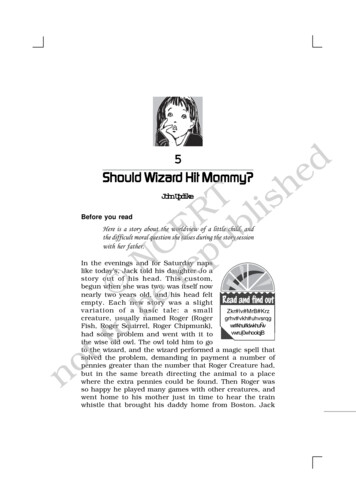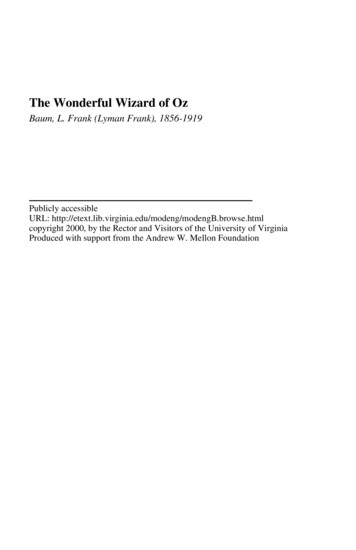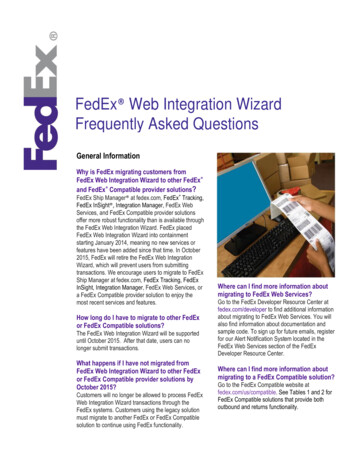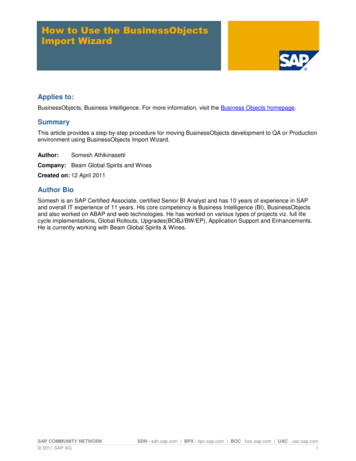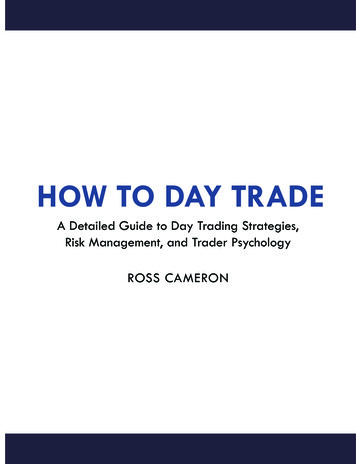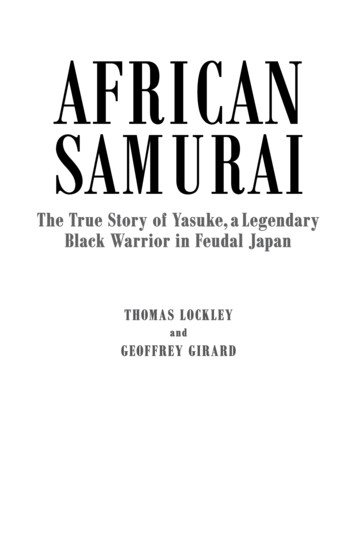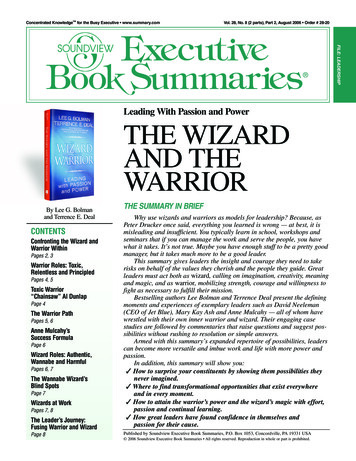
Transcription
Concentrated Knowledge for the Busy Executive www.summary.comVol. 28, No. 8 (2 parts), Part 2, August 2006 Order # 28-20Leading With Passion and PowerTHE WIZARDAND THEWARRIORBy Lee G. Bolmanand Terrence E. DealCONTENTSConfronting the Wizard andWarrior WithinPages 2, 3Warrior Roles: Toxic,Relentless and PrincipledPages 4, 5Toxic Warrior“Chainsaw” Al DunlapPage 4The Warrior PathPages 5, 6Anne Mulcahy’sSuccess FormulaPage 6Wizard Roles: Authentic,Wannabe and HarmfulPages 6, 7The Wannabe Wizard’sBlind SpotsPage 7Wizards at WorkPages 7, 8The Leader’s Journey:Fusing Warrior and WizardPage 8THE SUMMARY IN BRIEFWhy use wizards and warriors as models for leadership? Because, asPeter Drucker once said, everything you learned is wrong — at best, it ismisleading and insufficient. You typically learn in school, workshops andseminars that if you can manage the work and serve the people, you havewhat it takes. It’s not true. Maybe you have enough stuff to be a pretty goodmanager, but it takes much more to be a good leader.This summary gives leaders the insight and courage they need to takerisks on behalf of the values they cherish and the people they guide. Greatleaders must act both as wizard, calling on imagination, creativity, meaningand magic, and as warrior, mobilizing strength, courage and willingness tofight as necessary to fulfill their mission.Bestselling authors Lee Bolman and Terrence Deal present the definingmoments and experiences of exemplary leaders such as David Neeleman(CEO of Jet Blue), Mary Kay Ash and Anne Mulcahy — all of whom havewrestled with their own inner warrior and wizard. Their engaging casestudies are followed by commentaries that raise questions and suggest possibilities without rushing to resolution or simple answers.Armed with this summary’s expanded repertoire of possibilities, leaderscan become more versatile and imbue work and life with more power andpassion.In addition, this summary will show you: How to surprise your constituents by showing them possibilities theynever imagined. Where to find transformational opportunities that exist everywhereand in every moment. How to attain the warrior’s power and the wizard’s magic with effort,passion and continual learning. How great leaders have found confidence in themselves andpassion for their cause.Published by Soundview Executive Book Summaries, P.O. Box 1053, Concordville, PA 19331 USA 2006 Soundview Executive Book Summaries All rights reserved. Reproduction in whole or part is prohibited.FILE: LEADERSHIP
THE WIZARD AND THE WARRIORby Lee G. Bolman and Terrence E. Deal— THE COMPLETE SUMMARYConfronting the Wizard andWarrior WithinManagers are running on two cylinders — structureand people — when they need four. Two other frames —political and symbolic — are required to make sense ofthe roiling, moving targets that organizations serve upevery day. They take us into a world dominated by powerand passion. The bad news: That’s just where managersare usually weakest. We know this from research andacross sectors. Inattention to these two ways of thinkingand behaving is a debilitating Achilles’ heel.Managers shy away from politics because they see itsdynamics as sordid or because conflict scares them.They fear losing control and losing out. They cling to theillusion that if organizations were run right, they wouldn’t be political. Most managers have an even harder timegrasping the elusive and mysterious influence of symbols. Discounting culture as fuzzy and flaky, they don’tsee it, even though it’s there and influencing everythingthey do. Great leadership doesn’t happen withoutaddressing these political and cultural issues head-on.Leaders cannot afford to stay on the sidelines and play itsafe. Someone has to be willing to stand up and put it onthe line. That’s why we need more wizards and warriors.Thinking on Your FeetWizard and warrior are roles that you can choose toplay and learn to play better. Wizard and warrior imagesare metaphors to help you think on your feet. When, forexample, you are in dangerous and highly charged political situations, what are your options? There are threekinds of warrior — toxic, relentless and principled —and four key attributes that warriors need to be successful — mind, heart, skill and weapons.When the culture of your enterprise needs tweaking ortransforming, what are your wisest moves? There are threewizardly roles — authentic, wannabe and harmful — andspecific ways leaders can inspire, deflate or destroy a company. To be successful, wizards need to discover their ownmagic and spiritual core and then summon the collectivespirit through example, values, ritual, ceremony and stories.Defining moments in the lives of leaders from differenteras illuminate pathways to follow and pitfalls to avoid.These lessons can provide insight and perspective that willbe invaluable in your own defining moments. Knowingwhen to fight or when to invoke key symbols can determine whether you succeed or run aground.Light and ShadowRichard Nixon won the U.S. presidency in 1968 andagain in 1972. Ray Price, Nixon’s chief speechwriter,described Nixon as possessing both a very bright sideand a dark, thunderous side that was mostly hiddenfrom public view. Price and others on the presidentialstaff saw Nixon’s potential for greatness but worriedabout the darker angels of his nature. These often rendered him insecure, secretive, angry and vindictive.Fascinating and shadowy, brilliant and petty, loved andhated, Richard Nixon stands out as one of America’s mostcontroversial and cryptic presidents. As the only individualever to resign America’s highest office, he is conspicuouslyone of a kind. Yet the source of his fall — inability to recognize and manage competing demons — is the stuff ofShakespearian tragedy, a story repeated worldwide throughout history. Nixon’s demons lurk in even the best of us.Mother Teresa’s Vatican biographer wrote that she had aninterior life marked by an experience of a deep, painful andabiding feeling of being separated, even rejected by God.She called her inner experience, “the darkness.”Mother Teresa was born Agnes Gonxha Bojaxhiu in1910 to an Albanian Catholic family in Macedonia.(continued on page 3)The authors: Lee G. Bolman holds the MarionBloch/Missouri Chair in Leadership at the Bloch School ofBusiness and Public Administration at the University ofMissouri-Kansas City.Terrence E. Deal retired as the Irving R. Melbo ClinicalProfessor of the University of Southern California’s RossierSchool of Education.The Wizard and the Warrior by Lee G. Bolman andTerrence E. Deal. Copyright 2006 by John Wiley & Sons,Inc. Summarized by permission of the publisher, John Wiley& Sons, Inc. 248 pages, 27.95. ISBN 0-7879-7413-7.Summary Copyright 2006 by Soundview ExecutiveBook Summaries. www.summary.com, 1-800-SUMMARY,1-610-558-9495.For additional information on the authors,go to: http://my.summary.comPublished by Soundview Executive Book Summaries (ISSN 0747-2196), P.O. Box 1053, Concordville, PA19331 USA, a division of Concentrated Knowledge Corp. Published monthly. Subscriptions: 209 per year in theUnited States, Canada and Mexico, and 295 to all other countries. Periodicals postage paid at Concordville, Pa.,and additional offices.Postmaster: Send address changes to Soundview, P.O. Box 1053, Concordville, PA 19331. Copyright 2006by Soundview Executive Book Summaries.Available formats: Summaries are available in print, audio and electronic formats. To subscribe, call us at1-800-SUMMARY (610-558-9495 outside the United States and Canada), or order on the Internet at www.summary.com.Multiple-subscription discounts and corporate site licenses are also available.2Soundview Executive Book Summaries SoundviewExecutive Book Summaries DEBRA A. DEPRINZIO – Senior Graphic DesignerCHRIS LAUER – Senior EditorLINDA GROSS – Editor in ChiefREBECCA Y. CLEMENT – Publisher
The Wizard and the Warrior — SUMMARYConfronting the Wizard and Warrior Within(continued from page 2)When she was 18, she joined the Sisters of Loreto, anIrish religious community with missions in India. In1946 she was working at a Catholic high school inCalcutta. During a train ride that year, she received acall to serve the “poorest of the poor.” Alone and without funding, she began her new mission. In 1950, sheestablished a new Catholic religious order that built missions worldwide to serve the poor. By her death in1997, she had become an inspiration to the world forher commitment to doing “small things with great love.”Why would such a woman feel chronic emotionalpain? She, like Richard Nixon, had her darker side.Admired by most, she also attracted critics. She was apolitician as well as a saint. Her passion and faith weredeep and powerful. They fueled and sustained her commitment to her calling. But her impulses toward powerand self-promotion were equally robust. Her politicalinclinations were at the heart of her spiritual struggles.Conflicting ForcesRichard Nixon and Mother Teresa were larger-thanlife world figures, and both struggled to manage theconflicting forces in their psyches. Egged on by shortsighted advisers, Nixon let his ambition and his fearstrump his genius, with devastating results. MotherTeresa’s triumph was to turn similar tensions into apowerful creative force. She successfully rode the tigerof conflicting impulses and aligned them in support ofher call to serve the poor. Their divergent stories revealdeep truths about the risks and possibilities of leadership. Magic and power coexist in the world and in eachof us. So too do self-interest and ambition. The forcesof light and dark are uniformly real and powerful.Many of us hope to lead from our comfort zones. Wedeny our demons and avoid the inevitable tensionsbetween passion and politics. We disavow both warriorand wizard, hoping that expertise and people skills willget us where we want to go. It is a vain hope. In limiting ourselves and playing it safe, we lose touch withreality and close off access to our deeper psychic andspiritual power. We also forfeit the likelihood that wewill achieve anything interesting or important.Power and SpiritTo lead with passion and conviction, we need toembrace both power and spirit. We need to recognizeand follow a path of paradox and contradiction, apromising route right in front of us.When should a leader fight, and when should he orshe search for new options? Leaders must reflect abouthow they currently cope with this dilemma, and howthey might approach it differently in the future.There are four different roles in leadership:1. Analysts emphasize rationality, analysis, logic, factsand data. They believe that leaders must get the right information, analyze it correctly, and develop goals and strategybased on facts. They try to avoid or control emotions andpolitics to avoid distorted decisions and irrational action.2. Caregivers emphasize the importance of peopleand relationships. They prefer collaboration to competition and care as much about helping as winning. Theylook for ways to understand and respond to the needs,concerns and feelings of colleagues and constituents.3. Warriors believe that managers and leaders livein a world of conflict and scarce resources. Theleader’s job is mobilizing the resources needed to advocate and fight for the organization’s agenda. Warriorsemphasize the importance of building a power base:allies, resources, networks, coalitions. They welcomebattle and competition rather than fear or avoid it.4. Wizards bring imagination, insight, creativity,vision, meaning and magic to the work of leadership.They look beyond the surface of things to see new possibilities. They surprise and delight followers with newand imaginative solutions to old problems. They goadothers to be creative. They often work magic — accomplishing the impossible. The symbolic tools of theirtrade include icons, ritual, ceremony and stories.Organizational FramesThese four images correlate with four organizationalframes. The Analyst hews to the structural frame thatsees organizations as factories or machines, and focuseson their rational aspects. The Caregiver prefers thehuman resource frame, with its emphasis on alignmentbetween people and organizations. The Warrior corresponds to the political frame, which sees organizationsas arenas in which individuals and groups compete forpower and scarce resources. Finally, the Wizard alignswith the symbolic frame, with its emphasis on the cultural and nonrational features of organization.All four frames are critical for understanding life ingroups, organizations and societies. The warrior andwizard roles are the most neglected and the most important for leadership. Research over the last two decadeshas consistently found a paradox: Most managers relyprimarily on the structural and human resources perspectives, but the political and symbolic frames aremost often associated with effective leadership.The better people understand and use the possibilitiesof the wizard and warrior within, the more likely theyare to become leaders who bring clout, hope and faith toorganizations that have become neutered and sterile. For additional information on choosing a warrior role,go to: http://my.summary.comSoundview Executive Book Summaries 3
The Wizard and the Warrior — SUMMARYWarrior Roles: Toxic,Relentless and PrincipledThere are three distinct roles that warriors may play,each falling somewhere in the murky terrain betweenthe idealized knights and villainous ogres of legend andfiction. The role an individual plays is determined by acombination of history, character and circumstance.Recognizing the characteristics and consequences ofeach warrior role increases your ability to choose onethat fits a given situation, and to shift from one toanother as circumstances change.All leaders make enemies as well as friends. Theyinevitably generate mixed reactions and ambivalence, so itis a mistake to take too much comfort from the praise ofallies or suffer too much pain from the attacks of enemies.The warrior’s choice of role is further complicated by apersistent tension between noble aspirations and tediousrealities. Warriors are frequently wedged between the sublime and the mundane, between lofty imperatives of ademanding ethical code and constant temptations of baser,more expedient interests. This struggle arises in part fromthe gap between patriotic dreams and the grim reality ofthe battlefield. It also reflects the transitory nature ofhuman life. Since there is little time to waste, warriors areperennially tempted to grab what they can while they can.Finally, the role warriors play depends on the cause theyseek. For some the cause is narrow and selfish. Otherscommit themselves to a larger common good. There havebeen many warrior leaders in war, politics and business.Most have claimed to fight on behalf of some noble mission. Far fewer have ultimately succeeded in achievinggreat purposes and accomplishing their chosen agenda.Too many accumulate power and then use it badly,unleashing destructive forces that lead to waste and ruin.The Toxic WarriorAt the destructive end of the warrior continuum, we findthe toxic warrior, whose inner world is dominated by conflict and turmoil. In toxic warriors, the conflict betweenforces of dark and light rages with almost unmanageableintensity. They are, at worst, thugs and sadists. Theybelieve that victory and their own interests supersedeeverything else. They have little patience for ethical concerns; the end justifies the means. They are often brilliant,politically shrewd and charismatic. They may temporarilyachieve extraordinary heights, yet their truncated visionand moral flaws lead almost inevitably to tragedy.Adolph Hitler, Joseph Stalin and Pol Pot exemplify themost destructive of toxic warriors. Each amassed extraordinary power and changed history, but left a legacy ofdamage and death. Their commercial cousins includepeople like Leona Helmsley and “Chainsaw” Al Dunlap.Here are three guidelines for avoiding the path of the4Toxic Warrior“Chainsaw” Al DunlapWhile Al Dunlap was chief executive of Scott Paper,he more than doubled profits and market value. Heachieved this financial miracle by slashing head countand cutting “frills” like research and development. Hetold managers not to get involved in community activities, eliminated all corporate contributions to charity,and moved Scott’s headquarters from Philadelphia(where it had been for more than a century) to BocaRaton, Fla. (where Dunlap had a new home).A closer look at the bottom line revealed thatemployee morale sank and Scott lost market share inevery major product line. Dunlap did not stay longenough to find out whether he had sacrificed Scott’sfuture for short-term gains. After less than twoyears, he sold the company to its biggest competitorand walked away with almost 100 million.Sunbeam hired Dunlap in 1996 to work his managerial skills on its struggling appliance business. Dunlapstarted by laying off about half of Sunbeam’s work forceand he closed more than half of the company’s factoriesand warehouses. Inside Sunbeam, anyone who voicedconcern was soon out of a job. After an initial rise instock price, it went into a free fall in early 1998. With thecompany teetering towards bankruptcy, its board sackedDunlap less than two years after he came aboard.toxic warrior:1. Managers need a realistic sense of self.2. Be alert to signs of toxic leadership.3. Take on a new role. Move to a more productive stance.The Relentless WarriorMidway on the continuum is the relentless warrior —a tireless and passionate battler. Like their toxic counterparts, these warriors want to win, but they recognizethat some costs are too high. They will push the rules ofthe game only so far. Microsoft founder Bill Gates, U.S.President George W. Bush and Hewlett-Packard’sembattled CEO Carly Fiorina are among many examples of the relentless warrior.Relentless warriors are passionate about their aims.But they are pragmatic enough to know the dangers ofplunging recklessly over legal or ethical cliffs. Theyoften test and sometimes bend the rules but rarely breakthem. High-profile cases have shown that you lose ifyour actions put you in jail, or if the products of yourenterprise cause death or injury. One relentless warrior, asuccessful entrepreneur, summarized his perspective onbusiness ethics very simply: “Death and jail scare me.”Three strengths and limits of the relentless warrior are:Soundview Executive Book Summaries (continued on page 5)
The Wizard and the Warrior — SUMMARYWarrior Roles: Toxic, Relentless and Principled(continued from page 4)1. Relentless warriors’ courage, persistence anddetermination make them formidable foes.2. Relentless warriors excel when the objective isclear and they can advance against clearly definedadversaries.3. Relentless warriors’ constricted field of view,stubbornness and willingness to steamroller opponents cast them as polarizing figures.The Principled WarriorNearer to the light end of the continuum, we findprincipled warriors. They see victory as a means ratherthan an end, worthy only if honorable and in service ofa higher purpose. Mary Kay Ash, Abraham Lincoln andlegendary basketball coach John Wooden are examples.Principled warriors are particularly likely to alter thecourse of history. They leave a legacy for several reasons:1. Principled warriors put combat in perspectivebecause they are not in love with it.2. Principled warriors will sacrifice for a worthy cause.3. Commitment to a coherent set of purposes andvalues makes principled warriors most likely tomake a just and lasting difference. The Warrior PathRegardless of the role they play, warriors succeed througha combination of four basic ingredients: heart, mind, skilland weapons. Heart gives warriors passion, courage andpersistence — it is the “fire in the belly” — that propelsthem forward in the face of risk, confusion, danger andobstacles. Mind gives warriors
She successfully rode the tiger of conflicting impulses and aligned them in support of . we lose touch with reality and close off access to our deeper psychic and . They look beyond the surface of things to see new pos-sibilities. They surprise and delight followers with new and imaginative solutions to old problems. They goad


